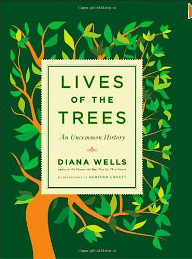Diana Wells
Books: Botany | Science | History
Lives of the Trees: An Uncommon History (2010)
 Well. That only took about six months to read. Maybe more.
Well. That only took about six months to read. Maybe more.
That's not to say it wasn't interesting, and that I didn't learn lots of fascinating stuff. But it was very good bedtime reading.
I have to say, one of the things I've come to love about the kindle, that I never even thought I'd use, is the highlighting. I can make highlights and write notes about them, which is very useful when I remember something later, and want easily find it. (OK, a the search function is also good for this, but sometimes I don't remember things in a searchable manner.)
The point being, I highlighted lots of fascinating bits in this book. Like, "The words 'tree' and 'truth' share the original Old English word root, treow." How could I note make note of that–and then share it?
Or that "(i)n Thailand spiritually unpredictable trees could not be transplanted into ordinary gardens because their unknown wild forces were feared."
Or consider this bit about apples:
To ensure the same apple as the parent, the tree as to be grated. The Etruscans practiced grafting, although not all cultures accepted the technique. The Jewish religion forbade it, but the Christian church encouraged grafting…Meddling with God's design by hybridization, though, was the subject of theological debate in Britain until almost the nineteenth century.
Hybridized trees weren't kosher? And Britain's issues with hybridization echoes the current arguments over GMOs.
And more religious bits:
Jews, Christians, and Muslims considered the likelihood that the banana was the Tree of Knowledge described in Genesis… The shape of the fruit was suggestive of carnal knowledge.
That makes a whole lot more sense to me, anyway.
In 1523, a Spanish missionary Father Petrus de Angleria pointed out (cacao) was a good kind of money, "which permits no speculation, since it cannot be kept very long."
I know many people who would be traumatized if these rules hadn't changed:
(C)offee drinking was banned at different times both in the East and West by Muslims and Christians. At one time in Constantinople, illicit coffee drinkers could be punished by being sewn into a sack and tossed into the sea.
Important to know, for the coming zombie apocolypse:
(M)ost churchyards included roan trees, planted to prevent the dead from rising out of their graves.
Wonder if their effective as a barrier.
Of course, there are also amusing historical tidbits.
Kalm wrote…(a)t first he thought he was immune to sumac allergy. After experimentally rubbing himself with the sape, he found this was note to be so, and wrote that he did not have "any desire" to repeat the experiment.
And martial bits.
Confederate troops were sometimes called butternuts because their uniforms were dyed with them.
Walnut wood, once cured, is very stable, and it was particularly prized for making gunstocks…Before World War I the German kaiser stockpiled American black walnut wood for equipping his army with guns.
The British thought poorly of American oaks until the USS Constitution (affectionately called Old Ironsides by American sailors) proved otherwise. Constructing that impregnable ship required fifteen hundred American oaks, but at that time there were still plenty left to supply the new nation's navy.
All in all, I found it full of lots of fascinating tidbits.
